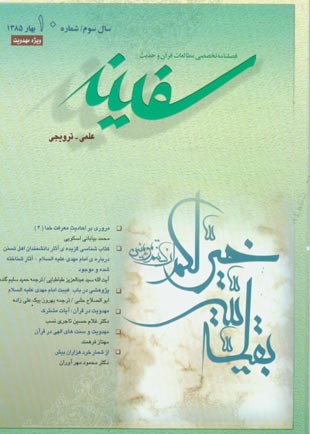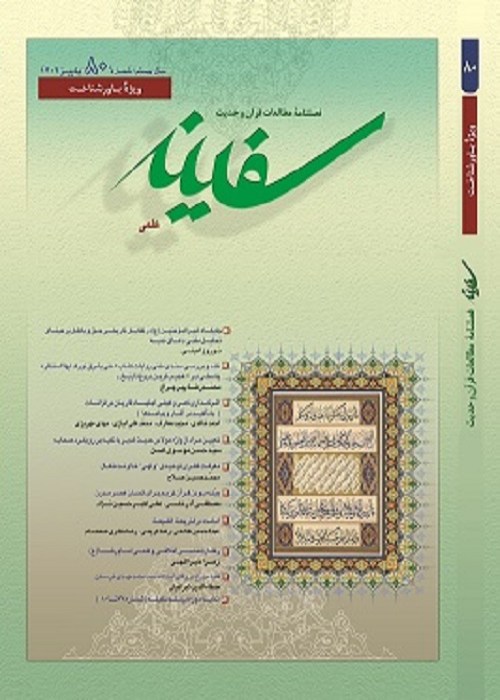فهرست مطالب

نشریه سفینه
پیاپی 10 (بهار 1385)
- 200 صفحه،
- تاریخ انتشار: 1385/02/12
- تعداد عناوین: 11
-
-
صفحه 3
- مقالات
-
صفحه 7نویسنده در این گفتار، نظرات برخی از محدثان، فقی هان و اندیشمندان قرن پانزدهم شیعه را در باب احادیث معرفهالله، به ترتیب زمان، نقل و نقد و بررسی میکند. علاوه بر جمعی از عالمان معاصر مانند حضرات آیات وحید خراسانی، صافی گلپایگانی، مکارم شیرازی و مصباح یزدی، دیدگاه های برخی دیگر از دانشمندان اخیر مانند آیتالله شیخ محمدباقر ملکی میانجی، آیتالله شیخ حسنعلی مروارید، شیخ علی محدث خراسانی و شیخ اسماعیل معتمد خراسانی نیز نقل و نقد و بررسی می شود. از آنجا که این مقاله در ادامه ی گفتارهای دیگر نویسنده در شماره های 6 تا 9 سفینه آمده، در این گفتار، تمام اقوال نقلشده در معنای معرفهالله بالله را در ضمن سه قول، خلاصه کرده است.
کلیدواژگان: توحید، روایات، احادیث معرفهالله، ملکی میانجی، محمدباقر، مرواید، حسنعلی، محدث خراسانی، علی، معتمد خراسانی، اسماعیل، وحید خراسانی، حسین، صافی گلپایگانی، لطفالله، مکارم شیرازی، ناصر، مصباح یزدی، محمدتقی -
صفحه 31در این گفتار، توضیحاتی پیرامون 27 کتاب از آثار دانشمندان اهل تسنن که آثاری مستقل درباره ی امام مهدی7به زبان عربی است، آمده است. تمام این آثار، مشهور، و نسخه های آن (خطی یا چاپی) شناختهشده و موجود است.
این گفتار، بر اساس کتاب «اهل البیت فی المکتبه العربیه» نوشته ی محقق طباطبایی کتابشناس برجسته و فقید معاصر (1348 1416 هجری قمری) فراهم آمده است. مترجم در مقدمهای کوتاه، شرح حال مختصر نویسنده و توضیحات کوتاه درباره ی کتاب یادشده آورده است. کتابهایی همچون اربعین حدیث نوشته ی ابونعیم اصفهانی، البرهان فی علامات مهدی آخرالزمان نوشته ی متقی هندی، العرف الوردی فی اخبار المهدی نوشته ی جلالالدین سیوطی، عقدالدرر فی اخبار المهدی المنتظر نوشته ی یوسفبنیحیی شافعی، القول المختصر فی علامات المهدی المنتظر نوشته ی ابنحجر هیتمی، از جمله کتابهای است که در این گفتار، شناسانده می شود.
کلیدواژگان: امام مهدی(ع)، کتابشناسی، آثار اهل تسنن، کتابشناسی، کتابهای عربی، کتابشناسی، طباطبایی یزدی، سید عبدالعزیز، اهل البیت فی المکتبه العربیه (کتاب)، اصالت مهدویت، دیدگاه اهل تسنن، اصفهانی، ابونعیم، اربعین حدیث (کتاب)، متقی هندی، علی -
صفحه 69ابوالصلاح حلبی (374 447 ه ق) محدث، فقیه و متکلم نامدار شیعی در قرن پنجم هجری قمری، بخشی از کتاب گرانقدر خود «تقریب المعارف» را به بحث درباره ی امام مهدی (ع) اختصاص داده و در آن، به یازده مبحث درباره ی غیبت حضرتش بر مبنای عقل و برهان پرداخته که برخی از آنها جنبه ی پاسخ به پرسشهای مطرح شده دارد. از دیدگاه ابوالصلاح حلبی، عقیده ی استوار به امامت امام مهدی (ع)، پاسخگوی بسیاری از پرسشهاست. همچنین ناامنی و نبودن یاور، دلیل موجه بر غیبت است. آیا فقدان لطف به علت عدم ظهور، با ثبوت تکلیف قابل جمع است؟ آیا خداوند، ضرر رساننده به حجت (ع) را مانع نمی شود؟ نگهداری شریعت، اجرای احکام، ارشاد گمراهان و ادای حقوق مالی توسط امام مهدی (ع) در زمان غیبت چگونه است؟ آیا می توان گفت که به وجود یا ظهور امام مهدی (ع) نیازی نیست؟ طول عمر حضرتش چگونه است؟ این پرسشها را ابوالصلاح حلبی مطرح کرده و به آنها پاسخ تحلیلی گفته است.
کلیدواژگان: امام مهدی (ع)، غیبت، کلام شیعی امامی، قرن پنجم، حلبی، ابوالصلاح، تقریب المعارف (کتاب)، امام مهدی (ع)، بحث طول عمر، غیبت امام مهدی (ع)، پاسخ به پرسشها، غیبت امام مهدی (ع)، حفظ دین و عقیده به امامت - بخش ویژه
-
صفحه 93نویسنده در این گفتار که هدف آن، نشان دادن ریشه های استوار عقیده ی مهدویت در قرآن است ابتدا ضرورت رجوع به تفسیر اثری / ماثور برای موضوع خود را ثابت می کند، سپس آیات مربوط به امام مهدی(ع) را که در قرآن آمده، به چند گروه تقسیم می کند: آیات مشترک، آیات متبع و آیات مختص. در هر کدام از این گروه ها، آیات قرآنی بر اساس تقسیم چهار بخشی دیگر، مرتب شده است. در این گفتار، فقط آیات مشترک مطرح شده، یعنی آیاتی که به اتفاق کتابهای تفسیری شیعی و سنی، درباره ی امام مهدی(ع) است.
در این گفتار مقدمهای در مورد تفسیر اثری آمده و پس از آن 9 آیه، حدود 50 حدیث و سه پیوست توضیحی در مورد آیات و روایات یاد شده است.
کلیدواژگان: قرآن، تفسیر اثری، امام مهدی(ع)، آیات مهدویت، تفسیر، شیعی و سنی، مهدویت، اصالت قرآنی -
صفحه 127نگارنده در این گفتار، سنت های الاهی استخلاف، امتحان و تمحیص، استدراج و املا را براساس قرآن و حدیث و بیانات مفسران، مطرح کرده و پیوند آنها را با اصل مهدویت، غیبت و ظهور و انتظار امام مهدی(ع) نشان داده است.
کلیدواژگان: امام مهدی (ع)، آیات مهدویت، مهدویت، اصالت قرآنی، قرآن، سنتهای الاهی، سنت استخلاف، سنت امتحان و تمحیص - گزارش و معرفی
-
صفحه 155
- یادنامه
-
صفحه 159این گفتار، درباره ی زندگی علمی، اساتید، شیوهی تحقیقی و آثار مکتوب علا مه محقق مرحوم شیخ محمد باقر محمودی (1341 1427 ه ق) است. نگارنده، سفرهای علمی علا مه محمودی، از شهرستان علامرودشت در جنوب استان فارس تا نجف و کربلا و پس از آن به قم توضیح داده است؛ آنگاه اساتید او و سپس به تفصیل ویژگی های اخلاقی و رفتاری او را برمی شمرد. روش کار و تحقیق علا مه محمودی، دیدگاه های بزرگان معاصر درباره ی ایشان، فهرست 33 اثر تالیف علا مه محمودی یا تحقیق متون کهن به دست ایشان به ویژه کتاب 14 جلدی «نهجالسعاده فی مستدرک نهجالبلاغه» در این گفتار، بیان شده است.
کلیدواژگان: محمودی، محمدباقر، محدثان شیعی امامی، قرن 14 و 14، نهجالبلاغه، مستدرکها، نهجالسعاده فی مستدرک نهجالبلاغه (کتاب)، علامرودشت، عالمان شیعی، متون کهن حدیثی، تصحیح و تحقیق - بازتاب
-
صفحه 189
-
صفحه 1
-
Page 7In this part, the writer provides The views of some of the prominent shia jurisprudent and traditionists of the recert century, under the title of "recognition of God" in a chronoligal way.In addition to the views of some of the contemporary scholars such as Ayatollahs vahid khorasani, Safi Golpaygani, Makarem shirazi, and Mesbah yazdi, the view point and definitions of other researchers, that have been published in recent years, such as Ayatollah Muhammad Baqer Malaki Mianaji, Shaikh Hasanali Morvarid, Shaikh Ali Mohaddeth khorasani, and Shaikh Ismaeil Moatamad khorasani, have also been reviewed and discussed.In this part, the respected writer has classified the who views and definitions which have been desribed in the last 4 issues, in three categories, and has provided this conclusions.
-
Page 31persian Translation by Hamid Salim GandomiIn this essay, you may find explanations about 27 independent books written about the 12th Imam, Hazrat Mahdi (may God accllerate his Reappearance) in the Arabic language, by the prominent and valuable Sunni writers and scholars. they are all well known books, and their original manuscripts are all available.This essay is prepared by the application of the valuable book of the respected contemporay writer and bibliographer, the late Ayatollah TabaTabaei, under the title, "The Prophet's household in the Arabic Literature."The translator in a short preface has provided the biography of the author, and useful information about the book.The books such as "al_ Arabaein" (40 traditions from the holy prophet) by Hafez Abu Noaim Esfahani, "al_Borhan fi Alamat_e_Mahdi_e_Akhar_e_ Zaman", by Mottaqii Hendi, "al_Arfull vardi fi Akhbare _e_ al_ Mahdi" by jalaluddin Siyouti, "Eqdud Durar fi Akhbare_e_al_ Mahdi al_ Montazar" by yousef bin Yahya Shafei and "al Qulul Mokhtasar fi Alamat_e_al Mahdi al Montazar", by Ibn Hajar Haitami are from the books introduced in this essay.
-
Page 69Persian Translation by Behrouz Beig AlizadehAbu Salah Halabi,the famous shia traditionist, jurisprudent and Theologian of the fifth century (A.H.) has dedicated a part of his valuable book, "Taqribul Maaref," to discuss about Imam al Mahdi (p.b.u.h). In that chapter he discussed eleven subjects about the absence of the holy Imam on the basis of rational reasons and intellect. Some of his discussions have been actually answers to the current available questions and ambiguities.According to Abu Salah Halabi a true and firm belif in the Divine leadership (Imamat) of Imam al Mahdi is a response to many questions. Moreover, in security and lack of enough supporter are sufficient and justifying reasons for his "absence".Some other questions that he has tried to answer, are as follow:1. Is the "absence" of Imam al Mahdi, a sign of the lack of divine kindness of guidance toward the human communities?2. Does not the Almighty God prevents those who intend to harm Imam al Mahdi (p.b.u.h)?3. How would be the procedure of "protection of religion", "enforcement of the Jurisprudence", "guidance of the misled people", and "settlement of the financial duties" of Imam al Mahdi (p.b.u.h) during the time of absence?Can one say and claim that there is no need for the existance er "Reappearance " of Imam al Mahdi? What is the secret of his long life? Abu Salah Halabi had asked the above questions, and then has given analytical explanatory answers to them.
-
Page 93In this essay, the writer shows the firm and decisive Quranic roots and supports for the belief of Mahdism. He first proves the necessity of referring to the traditions of the holy prophet and the infallible Imams which irterprete the verses of Quran. Then he classifies in the following categories:1. The commom veres,2. The secondary verses,3. The specialized verses recognized by either Shia oe Senni scholars, to be related to the Mahdism issue.Then in each clssification, the verses are orderd in four groups.In this essay just the common verses are brought, namely those verses, which according to the mutually accepted interpretations of the shia and sunni scholars and writres are about the holy Imam al Mahdi.This essay contains an introduction about the explanation of the holy Quran on the basis of the traditions and words of the infallible Imams. Then he brings and explains about 9 verses of Quram, 50 traditions, and brings three explanatory indesces about those verses and traditions.
-
Page 127The respected writer has discussed, in this essay, a bout the divine traditions such as "divine leadership and succesion", " divine examination", " divine opportunity for the wrongdoer(s)", and "divine deterioration and punishment", according to the holy verses, the Islamic traditions, and the writings of the interpretors, and has revealed the relations between the above mentioned traditions and Mahdism, the "absence", "Reappearance" and " waiting of the muslims for Imam al Mahdi (p.b.u.h)".
-
Page 159This article talks about the biography, studies, and works of the late scholar, shaikh Muhammad Baqer Mahmoudi (1922 ö 2006). there is a story given about his scientific trips, from his homeland, AlaMarvDasht (in southern part of fars province in Iran) to Najaf, and Karbala, and then his return to Qum, in Iran. Then his teachers and instructors are introduced, and some of his honorable moral and behavorial characteristics are described.His method of recearch, the viewpoints of his contemporary researchers about him, and a short list of his compiled works, the old texts or manuscripts, which have been corrected and edited by him, especially the 14 volume work of " Nahjul saada fi Mostadrak_ e _ Nahjul balagha" are introduced in this article.


